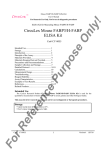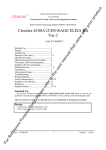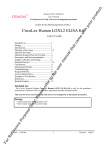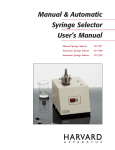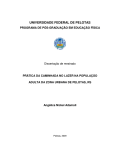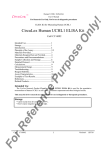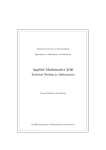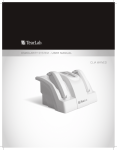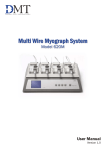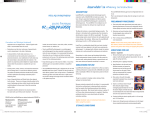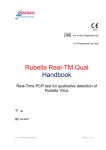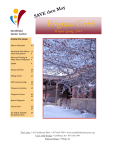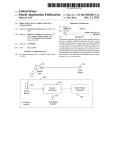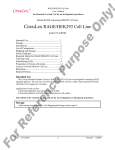Download CircuLex Human Lacritin ELISA Kit
Transcript
Human Lacritin ELISA Kit User’s Manual For Research Use Only, Not for use in diagnostic procedures ELISA Kit for Measuring Human Lacritin On ly! CircuLex TM CircuLex Human Lacritin ELISA Kit Cat# CY-8105 Pu rp os e Intended Use................................................ 1 Storage......................................................... 1 Introduction.................................................. 2 Principle of the Assay.................................. 2-3 Materials Provided....................................... 3 Materials Required but not Provided........... 4 Precautions and Recommendations.............. 5 Sample Collection and Storage.................... 6 Detailed Protocol.......................................... 8-9 Calculations..................................…............ 10 Measurement Range..................................... 10 Troubleshooting............................................ 10 Reagent Stability.......................................... 10 Assay Characteristics................................... 11-13 Example of Test Results............................... 14 References.................................................... 15 Related Products.......................................... 16 ce Intended Use The CycLex Research Product CircuLex Human Lacritin ELISA Kit is used for the quantitative measurement of human lacritin in tear fluid, cell culture supernatant, and other biological media. en This assay kit is for research use only and not for use in diagnostic or therapeutic procedures. Storage rR ef er • Upon receipt store all components at 4°C. • Don’t expose reagents to excessive light. Fo Cat#: CY-8105 1 Version#: 150611 Human Lacritin ELISA Kit User’s Manual For Research Use Only, Not for use in diagnostic procedures On ly! CircuLex TM Introduction os e Lacritin is a 12.3 kDa tear glycoprotein that is apically released from human lacrimal acinar cells during reflex tearing (1-3) and can be detected in mixed reflex and basal human tears (4, 5). Lacritin is produced by corneal, conjunctival (5), meibomian (6) as one of the most eye-restricted genes. However it has been detected in a subpopulation of ductal cells in salivary glands, thyroid (4) and mammary glands (7). Lacritin modulates lacrimal acinar cell secretion, promotes ductal cell proliferation, and stimulates signaling through tyrosine phosphorylation and release of calcium. Since a decrease of tear lacritin was reported in patients with blepharitis (8) and in contact lens–related dry eye (9), lacritin might play an important role in maintaining tear fluid and the ocular surface. In fact, ocular instillation of recombinant human lacritin stimulated basal tear flow in rabbits (10). Lacritin also promotes basal tear secretion by cultured rat (4) and monkey (3) lacrimal acinar cells and stimulates human corneal epithelial cell growth (11). Thus, lacritin appears to be a multifunctional eye-specific factor with a potential role in tear secretion and corneal epithelial renewal Pu rp Principle of the Assay rR ef er en ce The CycLex Research Product CircuLex Human Lacritin ELISA Kit employs the quantitative sandwich enzyme immunoassay technique. An antibody specific for human lacritin is pre-coated onto a microplate. Standards and samples are pipetted into the wells and the immobilized antibody binds any human lacritin present. After washing away any unbound substances, an HRP conjugated antibody specific for human lacritin is added to the wells. Following a wash to remove any unbound antibody HRP conjugate, the remaining conjugate is allowed to react with the substrate H2O2tetramethylbenzidine. The reaction is stopped by addition of acidic solution and absorbance of the resulting yellow product is measured at 450 nm. The absorbance is proportional to the concentration of human lacritin. A standard curve is constructed by plotting absorbance values versus human lacritin concentrations of calibrators, and concentrations of unknown samples are determined using this standard curve. Fo Cat#: CY-8105 2 Version#: 150611 Human Lacritin ELISA Kit User’s Manual For Research Use Only, Not for use in diagnostic procedures Summary of Procedure Add 100 µL of diluted samples to the wells Incubate for 1 hour at room temp. Wash the wells On ly! CircuLex TM Add 100 µL of HRP conjugated anti-human lacritin antibody Wash the wells Add 100 µL of Substrate Reagent Pu rp Add 100 µL of Stop Solution os e Incubate for 1 hour at room temp. Measure absorbance at 450 nm Materials Provided All samples and standards should be assayed in duplicate. The following components are supplied and are sufficient for the one 96-well microplate kit. ce Microplate: One microplate supplied ready to use, with 96 wells (12 strips of 8-wells) in a foil, zip-lock bag with a desiccant pack. Wells are coated with anti-human lacritin antibody as a capture antibody. 10X Wash Buffer: One bottle containing 100 mL of 10X buffer containing Tween®-20. en Dilution Buffer: One bottle containing 50 mL of 1X buffer; use for reconstitution of human lacritin Standard and sample dilution. Ready to use. Human Lacritin Standard: One vial containing 44 ng of lyophilized recombinant human lacritin. er HRP conjugated Detection Antibody: One bottle containing 12 mL of HRP (horseradish peroxidase) conjugated anti-human lacritin antibody. Ready to use. ef Substrate Reagent: One bottle containing 20 mL of the chromogenic substrate, tetra-methylbenzidine (TMB). Ready to use. rR Stop Solution: One bottle containing 20 mL of 1 N H2SO4. Ready to use. Fo Cat#: CY-8105 3 Version#: 150611 Human Lacritin ELISA Kit User’s Manual For Research Use Only, Not for use in diagnostic procedures On ly! CircuLex TM Materials Required but not Provided • Pipettors: 2-20 µL, 20-200 µL and 200-1000 µL precision pipettors with disposable tips • Precision repeating pipettor • Orbital microplate shaker • Microcentrifuge and tubes for sample preparation os e • Vortex mixer • Microplate washer: optional (Manual washing is possible but not preferable) • Plate reader: capable of measuring absorbance in 96-well plates at dual wavelengths of 450/540 nm. Dual wavelengths of 450/550 or 450/595 nm can also be used. The plate can also be read at a single wavelength of 450 nm, which will give a somewhat higher reading. • 500 or 1000 mL graduated cylinder • Reagent reservoirs • Deionized water of the highest quality rR ef er en ce • Disposable paper towels Pu rp • Software package facilitating data generation and analysis: optional Fo Cat#: CY-8105 4 Version#: 150611 Human Lacritin ELISA Kit User’s Manual For Research Use Only, Not for use in diagnostic procedures Precautions and Recommendations • Allow all the components to come to room temperature before use. On ly! CircuLex TM • All microplate strips that are not immediately required should be returned to the zip-lock pouch, which must be carefully resealed to avoid moisture absorption. • Do not use kit components beyond the indicated kit expiration date. os e • Use only the microtiter wells provided with the kit. • Rinse all detergent residues from glassware. • Use deionized water of the highest quality. • Do not mix reagents from different kits. Pu rp • The buffers and reagents used in this kit contain NaN3 as preservatives. Care should be taken to avoid direct contact with these reagents. • Do not mouth pipette or ingest any of the reagents. • Do not smoke, eat, or drink when performing the assay or in areas where samples or reagents are handled. • Dispose of tetra-methylbenzidine (TMB) containing solutions in compliance with local regulations. • Avoid contact with the acidic Stop Solution and Substrate Solution, which contains hydrogen peroxide. ce • Wear gloves and eye protection when handling immunodiagnostic materials and samples of human origin, and these reagents. In case of contact with the Stop Solution and the Substrate Solution, wash skin thoroughly with water and seek medical attention, when necessary. en • Biological samples may be contaminated with infectious agents. Do not ingest, expose to open wounds or breathe aerosols. Wear protective gloves and dispose of biological samples properly. rR ef er • CAUTION: Sulfuric Acid is a strong acid. Wear disposable gloves and eye protection when handling Stop Solution. Fo Cat#: CY-8105 5 Version#: 150611 Human Lacritin ELISA Kit User’s Manual For Research Use Only, Not for use in diagnostic procedures On ly! CircuLex TM Sample Collection and Storage Tear fluid: Remove any particulates by centrifugation and assay immediately or aliquot and store samples at below -70°C. Avoid repeated freeze-thaw cycles. Cell culture supernatant: Remove any particulates by centrifugation and assay immediately or aliquot and store samples at below -70°C. Avoid repeated freeze-thaw cycles. os e Other biological samples: Remove any particulates by centrifugation and assay immediately or aliquot and store samples at below -70°C. Avoid repeated freeze-thaw cycles. For reference Serum: Use a serum separator tube and allow samples to clot for 60 ± 30 minutes. Centrifuge the samples at 4°C for 10 minutes at 1,000 x g. Remove serum and assay immediately or store samples on ice for up to 6 hours before assaying. Aliquots of serum may also be stored at below -70°C for extended periods of time. Avoid repeated freeze-thaw cycles. Pu rp Plasma: Collect plasma using EDTA-Na2 as the anticoagulant. If possible, collect the plasma into a mixture of EDTA-Na2 and Futhan to stabilize the sample against spontaneous in vitro complement activation. Immediately centrifuge samples at 4°C for 15 minutes at 1,000 x g. Assay immediately or store samples on ice for up to 6 hours before assaying. Aliquots of plasma may also be stored at below -70°C for extended periods of time. Avoid repeated freeze-thaw cycles. Note: Citrate plasma has not been validated for use in this assay. Preparation of tear extract from Schirmer’s test strip: ce 1. Place one free end of the Schirmer’s test strip within your lower eyelid. Both eyes are tested at the same time. 2. Keep your eyes gently closed for 5 minutes. en 3. Remove the wet test strips from each lower eyelid. 4. Cut the wet test strip 5 mm length with scissors or cutter. 6. Transfer 5 mm piece of the wet test strip to microcentrifuge tube. er 7. Add 300 µl PBS with protease inhibitor cocktail to the microcentrifuge tube, incubated at 4°C for 3 hours with intermittent mixing. 8. Centrifuge at 15,000 rpm for 5 minutes at 4°C. ef 9. Transfer the supernatant to new microcentrifuge tube, store at -80°C until processing. • This tear extract from Schirmer’s test strip requires 100- to 300-fold dilution for Assay. rR The tear extract from Schirmer’s test strip can be stored at below -70°C. Avoid multiple freeze/thaw cycles. After thaw the tear extract, Centrifuge at 15,000 rpm for 5 minutes at 4°C again since the cell Fo Cat#: CY-8105 6 Version#: 150611 Human Lacritin ELISA Kit User’s Manual For Research Use Only, Not for use in diagnostic procedures On ly! CircuLex TM lysates should be clear of any sediments or particulate matter. Typical data using this protocol are shown in Fig. 1 of the section "Example of Test Results" below. rR ef er en ce Pu rp os e NOTE: THE ABOVE PROCEDURES ARE INTENDED ONLY AS A GUIDELINE. THE OPTIMAL EXPERIMENTAL CONDITIONS WILL VARY DEPENDING ON THE PARAMETERS BEING INVESTIGATED, AND MUST BE DETERMINED BY THE INDIVIDUAL USER. NO WARRANTY OR GUARANTEE OF PERFORMANCE USING THESE PROCEDURES IS MADE OR IMPLIED. Fo Cat#: CY-8105 7 Version#: 150611 Human Lacritin ELISA Kit User’s Manual For Research Use Only, Not for use in diagnostic procedures On ly! CircuLex TM Detailed Protocol The CycLex Research Product CircuLex Human Lacritin ELISA Kit is provided with removable strips of wells so the assay can be carried out on separate occasions using only the number of strips required for the particular determination. Since experimental conditions may vary, an aliquot of the Human Lacritin Standard within the kit should be included in each assay as a calibrator. Disposable pipette tips and reagent troughs should be used for all liquid transfers to avoid cross-contamination of reagents or samples. Preparation of Working Solutions os e All reagents need to be brought to room temperature prior to the assay. Assay reagents are supplied ready-to-use, with the exception of 10X Wash Buffer and Human Lacritin Standard. 1. Prepare a working solution of Wash Buffer by adding 100 mL of the 10X Wash Buffer to 900 mL of deionized (distilled) water. Mix well. Store at 4°C for two weeks or -20°C for long-term storage. Pu rp 2. Reconstitute Human Lacritin Standard with 1 mL of Dilution Buffer. The concentration of the human lacritin in vial should be 44 ng/mL, which is referred as a Master Standard of human lacritin. Prepare Standard Solutions as follows: Use the Master Standard to produce a dilution series (below). Mix each tube thoroughly before the next transfer. The 3,000 pg/mL standard (Std.1) serves as the highest standard. The Dilution Buffer serves as the zero standard (Blank). Volume of Standard 50 µL of Master Standard (44 ng/mL) 300 µL of Std. 1 (3,000 pg/mL) 300 µL of Std. 2 (1,500 pg/mL) 300 µL of Std. 3 (750 pg/mL) 300 µL of Std. 4 (375 pg/mL) 300 µL of Std. 5 (187.5 pg/mL) 300 µL of Std. 6 (93.8 pg/mL) en ce Std.1 Std.2 Std.3 Std.4 Std.5 Std.6 Std.7 Blank Dilution Buffer 683 µL 300 µL 300 µL 300 µL 300 µL 300 µL 300 µL 300 µL - Concentration 3,000 pg/mL 1,500 pg/mL 750 pg/mL 375 pg/mL 187.5 pg/mL 93.8 pg/mL 46.9 pg/mL 0 pg/mL er Note: Do not use a repeating pipette. Change tips for every dilution. Unused portions of Master Standard should be aliquoted and stored at below -70°C immediately. Avoid multiple freeze and thaw cycles. Sample Preparation rR ef • Tear fluid requires 5,000- to 10,000-fold dilution. • Tear extract from Schirmer’s test strip requires 100- to 300-fold dilution. • Other biological samples require neat to appropriate dilution. Fo Cat#: CY-8105 8 Version#: 150611 Human Lacritin ELISA Kit User’s Manual For Research Use Only, Not for use in diagnostic procedures Standard Assay Procedure for Human Lacritin On ly! CircuLex TM 1. Remove the appropriate number of microtiter wells from the foil pouch and place them into the well holder. Return any unused wells to the foil pouch, refold, seal with tape and store at 4°C. 2. Dilute samples with Dilution Buffer. (See “Sample Preparation” above.) 3. Pipette 100 µL of Standard Solutions (Std1-Std7, Blank) and diluted samples in duplicates, into the appropriate wells. os e 4. Incubate the plate at room temperature (ca.25°C) for 1 hour, shaking at ca. 300 rpm on an orbital microplate shaker. 5. Wash 4-times by filling each well with Wash Buffer (350 µL) using a squirt bottle, multi-channel pipette, manifold dispenser or microplate washer. 6. Add 100 µL of HRP conjugated Detection Antibody into each well. Pu rp 7. Incubate the plate at room temperature (ca.25°C) for 1 hour, shaking at ca. 300 rpm on an orbital microplate shaker. 8. Wash 4-times by filling each well with Wash Buffer (350 µL) using a squirt bottle, multi-channel pipette, manifold dispenser or microplate washer. 9. Add 100 µL of Substrate Reagent. Avoid exposing the microtiter plate to direct sunlight. Covering the plate with e.g. aluminum foil is recommended. Return Substrate Reagent to 4°C immediately after the necessary volume is removed ce 10. Incubate the plate at room temperature (ca.25°C) for 10-20 minutes, shaking at ca. 300 rpm on an orbital microplate shaker. The incubation time may be extended up to 30 minutes if the reaction temperature is below 20°C. 11. Add 100 µL of Stop Solution to each well in the same order as the previously added Substrate Reagent. en 12. Measure absorbance in each well using a spectrophotometric microplate reader at dual wavelengths of 450/540 nm. Dual wavelengths of 450/550 or 450/595 nm can also be used. Read the microplate at 450 nm if only a single wavelength can be used. Wells must be read within 30 minutes of adding the Stop Solution. rR ef er Note-1: Complete removal of liquid at each step is essential to good performance. After the last wash, remove any remaining Wash Buffer by aspirating or decanting. Invert the plate and blot it against clean paper towels. Note-2: Reliable standard curves are obtained when either O.D. values do not exceed 0.25 units for the blank (zero concentration), or 3.0 units for the highest standard concentration. The plate should be monitored at 5-minute intervals for approximately 30 minutes. Note-3: If the microplate reader is not capable of reading absorbance greater than the absorbance of the highest standard, perform a second reading at 405 nm. A new standard curve, constructed using the values measured at 405 nm, is used to determine human lacritin concentration of off-scale samples. The readings at 405 nm should not replace the on-scale readings at 450 nm. Fo Cat#: CY-8105 9 Version#: 150611 Human Lacritin ELISA Kit User’s Manual For Research Use Only, Not for use in diagnostic procedures On ly! CircuLex TM Calculations os e Average the duplicate readings for each standard, control, and sample and subtract the average zero standard optical density. Plot the optical density for the standards versus the concentration of the standards and draw the best curve. The data can be linearized by using log/log paper and regression analysis may be applied to the log transformation. To determine the human lacritin concentration of each sample, first find the absorbance value on the y-axis and extend a horizontal line to the standard curve. At the point of intersection, extend a vertical line to the x-axis and read the corresponding human lacritin concentration. If the samples have been diluted, the concentration read from the standard curve must be multiplied by the dilution factor. 1. The dose-response curve of this assay fits best to a sigmoidal 4-parameter logistic equation. The results of unknown samples can be calculated with any computer program having a 4-parameter logistic function. It is important to make an appropriate mathematical adjustment to accommodate for the dilution factor. Pu rp 2. Most microtiter plate readers perform automatic calculations of analyte concentration. The calibration curve is constructed by plotting the absorbance (Y) of calibrators versus log of the known concentration (X) of calibrators, using the 4-parameter function. Alternatively, the logit log function can be used to linearize the calibration curve (i.e. logit of absorbance (Y) is plotted versus log of the known concentration (X) of calibrators). Measurement Range The measurement range is 46.9 pg/mL to 3,000 pg/mL. Any sample reading higher than the highest standard should be diluted with Dilution Buffer in higher dilution and re-assayed. Dilution factors need to be taken into consideration in calculating the human lacritin concentration. ce Troubleshooting 1. The Human Lacritin Standard should be run in duplicate, using the protocol described in the Detailed Protocol. Incubation times or temperatures significantly different from those specified may give erroneous results. en 2. Poor duplicates, accompanied by elevated values for wells containing no sample, indicate insufficient washing. If all instructions in the Detailed Protocol were followed accurately, such results indicate a need for washer maintenance. er 3. Overall low signal may indicate that desiccation of the plate has occurred between the final wash and addition of Substrate Reagent. Do not allow the plate to dry out. Add Substrate Reagent immediately after wash. ef Reagent Stability rR All of the reagents included in the CycLex Research Product CircuLex Human Lacritin ELISA Kit have been tested for stability. Reagents should not be used beyond the stated expiration date. Upon receipt, kit reagents should be stored at 4°C, except the reconstituted Human Lacritin Standard must be stored at below -70°C. Coated assay plates should be stored in the original foil bag sealed by the zip lock and containing a desiccant pack. Fo Cat#: CY-8105 10 Version#: 150611 Human Lacritin ELISA Kit User’s Manual For Research Use Only, Not for use in diagnostic procedures On ly! CircuLex TM Assay Characteristics 1. Sensitivity The limit of detection (defined as such a concentration of human lacritin giving absorbance higher than mean absorbance of blank* plus three standard deviations of the absorbance of blank: A blank + 3SD blank) is better than 32.4 pg/mL of sample. os e * Dilution Buffer is pipetted into blank wells. rR ef er en ce Pu rp Typical Standard Curve Fo Cat#: CY-8105 11 Version#: 150611 Human Lacritin ELISA Kit User’s Manual For Research Use Only, Not for use in diagnostic procedures On ly! CircuLex TM 2. Precision Intra-assay Precision (Precision within an assay) Three samples* of known concentration were tested four times on one plate to assess intra-assay precision. • Intra-assay (Within-Run, n=4) CV=4.6-5.4% *Sample: Human tear Pu rp os e Human lacritin conc. (ng/mL) Inter-assay Precision (Precision between assays) Three samples* of known concentration were tested in four separate assays to assess inter-assay precision. • Inter-assay (Run-to-Run, n=4) CV=2.4-8.5% rR ce ef er en Human lacritin conc. (ng/mL) *Sample: Human tear Fo Cat#: CY-8105 12 Version#: 150611 Human Lacritin ELISA Kit User’s Manual For Research Use Only, Not for use in diagnostic procedures On ly! CircuLex TM 3. Linearity rR ef er en ce Pu rp os e Three samples* were diluted with Dilution Buffer and assayed after dilution. The neat sample is set to 1. The results are summarized in the figure below. *Sample: Human tear Fo Cat#: CY-8105 13 Version#: 150611 Human Lacritin ELISA Kit User’s Manual For Research Use Only, Not for use in diagnostic procedures Example of Test Results Pu rp os e Fig.1 Human lacritin concentration in tear extracts from Schirmer’s test strips On ly! CircuLex TM rR ef er en ce Fig.2 Human lacritin concentration in tear fluids from two healthy volunteers Fo Cat#: CY-8105 14 Version#: 150611 Human Lacritin ELISA Kit User’s Manual For Research Use Only, Not for use in diagnostic procedures On ly! CircuLex TM References 1. Ma P, Wang N, McKown RL, Raab RW, Laurie GW.; Focus on molecules: lacritin. Exp Eye Res. 2008; 86: 457–458. 2. McKown RL, Wang N, Raab RW, et al.; Lacritin and other new proteins of the lacrimal functional unit. Exp Eye Res. 2009; 88: 848–858. os e 3. Morimoto-Tochigi A, Walkup RD, Nakajima E, Shearer TR, Azuma M.; Mechanism for carbachol-induced secretion of lacritin in cultured monkey lacrimal acinar cells. Invest Ophthalmol Vis Sci. 2010; 51: 4395–4406. 4. Sanghi S, Kumar R, Lumsden A, et al.; cDNA and genomic cloning of lacritin, a novel secretion enhancing factor from the human lacrimal gland. J Mol Biol. 2001; 310: 127–139. Pu rp 5. Nakajima T, Walkup RD, Tochigi A, Shearer TR, Azuma M.; Establishment of an appropriate animal model for lacritin studies: cloning and characterization of lacritin in monkey eyes. Exp Eye Res. 2007; 85: 651–658. 6. Tsai PS, Evans JE, Green KM, et al.; Proteomic analysis of human meibomian gland secretions. Br J Ophthalmol. 2006; 90: 372–377. 7. Weigelt, B, Bosma, A.J, van 't Veer, L.J.; Expression of a novel lacrimal gland gene lacritin in human breast tissues. J Cancer Res Clin Oncol. 2003; 129: 735-6. ce 8. Koo B, Lee D, Ha H, Kim JC, Kim CW.; Comparative analysis of the tear protein expression in blepharitis patients using two-dimensional electrophoresis. J Proteome Res. 2005; 4: 719–724. en 9. Nichols JJ, Green-Church KB.; Mass spectrometry-based proteomic analyses in contact lens-related dry eye. Cornea. 2009; 28: 1109–1117. 10. Samudre S, Lattanzio FA Jr, Lossen V, et al.; Lacritin, a novel human tear glycoprotein, promotes sustained basal tearing and is well tolerated. Invest Ophthalmol Vis Sci. 2011;52: 6265–6270. rR ef er 11. Wang J, Wang N, Xie J, et al.; Restricted epithelial proliferation by lacritin via PKCalpha-dependent NFAT and mTOR pathways. J Cell Biol. 2006; 174: 689–700. Fo Cat#: CY-8105 15 Version#: 150611 Human Lacritin ELISA Kit User’s Manual For Research Use Only, Not for use in diagnostic procedures On ly! CircuLex TM Related Products os e * CircuLex S100A4 ELISA Kit Ver.2: Cat# CY-8086 * CircuLex S100A6 ELISA Kit: Cat# CY-8097 * CircuLex S100A10 ELISA Kit: Cat# CY-8095 * CircuLex S100A11 ELISA Kit: Cat# CY-8063 * CircuLex S100A14 ELISA Kit: Cat# CY-8064 * CircuLex S100P ELISA Kit: Cat# CY-8060 PRODUCED BY Pu rp CycLex Co., Ltd. 1063-103 Terasawaoka Ina, Nagano 396-0002 Japan Fax: +81-265-76-7618 e-mail: [email protected] URL: http://www.cyclex.co.jp rR ef er en ce CycLex/CircuLex products are supplied for research use only. CycLex/CircuLex products and components thereof may not be resold, modified for resale, or used to manufacture commercial products without prior written approval from CycLex Co., Ltd.. To inquire about licensing for such commercial use, please contact us via email. Fo Cat#: CY-8105 16 Version#: 150611


















